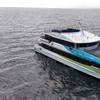Facing an exodus of institutional brain power as baby-boomer scientists retire, the Navy is turning to a younger pool of talent for its underwater robotics program, the Washington Post reported. As part of the effort, college students were recently invited to build robots that could perform a series of tasks without human control in a 38-ft. deep research pool. The culmination, the International Autonomous Underwater Vehicle Competition, was a sink-or-swim contest. The robots were required to swim through a gate, find and dock with a flashing light box, locate and tag a cracked pipeline, then home in on an acoustic beacon and resurface in a designated recovery zone. Top prize was $7,000.
In the nine-year history of the event, about 14 competitors have been recruited by the Navy or by private firms as part of the next generation of engineers who make robots for the military.
A total of 21 teams competed in this year's event, with the University of Florida's robot, named the SubjuGator, winning the contest for the second year straight. Florida's 12-man team- contest participants were overwhelmingly male- was sponsored by defense contractor Lockheed Martin Corp., with backing coming from other companies including Microsoft Corp. and Intel Corp. Other defense companies, like Northrop Grumman Corp., sponsored the contest and robot manufacturer Applied Research Associates Inc. had a stall at the event in the hopes of luring new talent. Matthew Koenn, who wrote the computer code that enabled the SubjuGator to "see" the pool floor, said the robot's 35-lbs. weight made it faster and more maneuverable than others that were closer to the competition's maximum of 140 lbs.
Most robots in this year's competition were cylindrical or torpedo-shaped. Duke University, which finished second, chose a circular design that resembled a flying saucer. Brian Hilgerford, 22, a Duke graduate, said the shape enabled the machine to move sharply in any direction, unlike the torpedo-shaped robots, which must turn in a wide circle.
The robots all came with an array of thrusters, external sensors, cameras and droppers.
Teams from as far as India and Japan competed. The youngest were 14 years old, from Amador Valley High School in Pleasanton, near San Francisco. Some machines performed according to plan; others seemed to have a mind of their own. Instead of swimming through a clearly marked gate, Cornell University's underwater robot, named Seamonkey, veered hard to the right and headed toward the edge of the pool. It finished seventh. (Source: Washington Post)
Sponsored Content
Innovative Hull Maintenance: Profitable & Green

December 2024
 Read the Magazine
Read the Magazine

 Read the Magazine
Read the Magazine
This issue sponsored by:

Propulsion Choices begin with Fuel and End with Politics
Subscribe for
Maritime Reporter E-News
Maritime Reporter E-News is the maritime industry's largest circulation and most authoritative ENews Service, delivered to your Email five times per week










